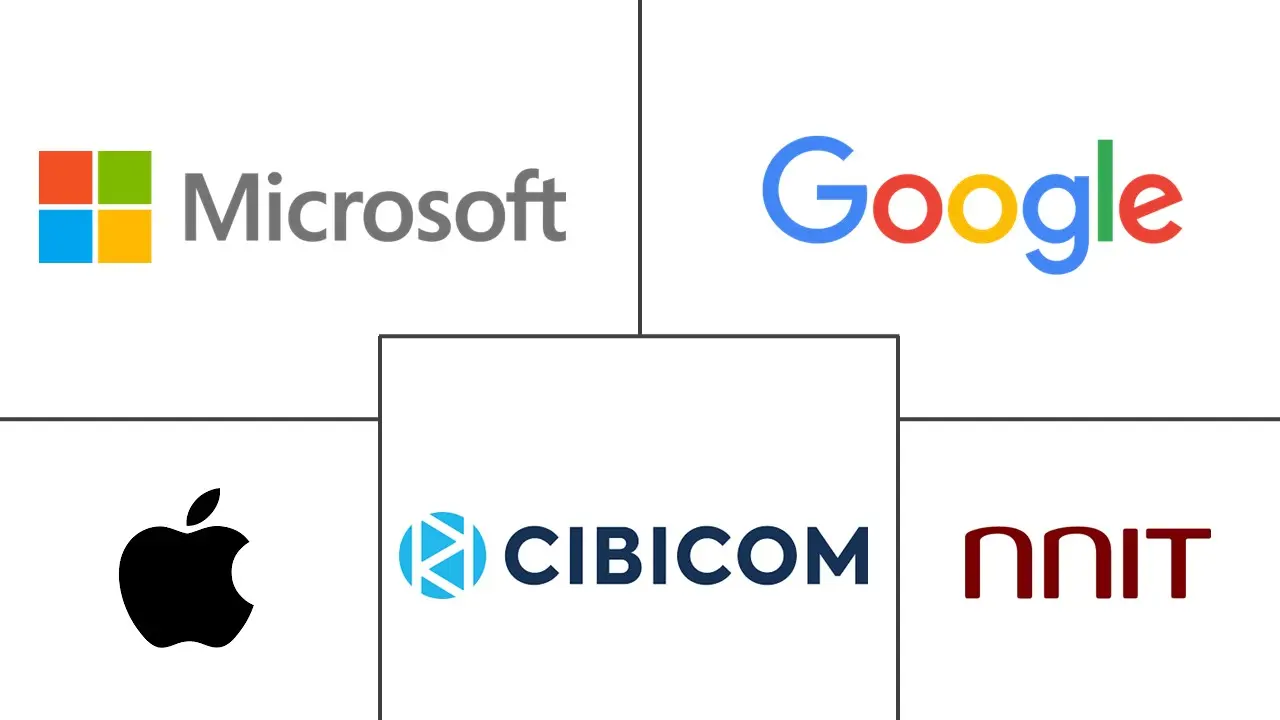Denmark Data Center Market Size and Share
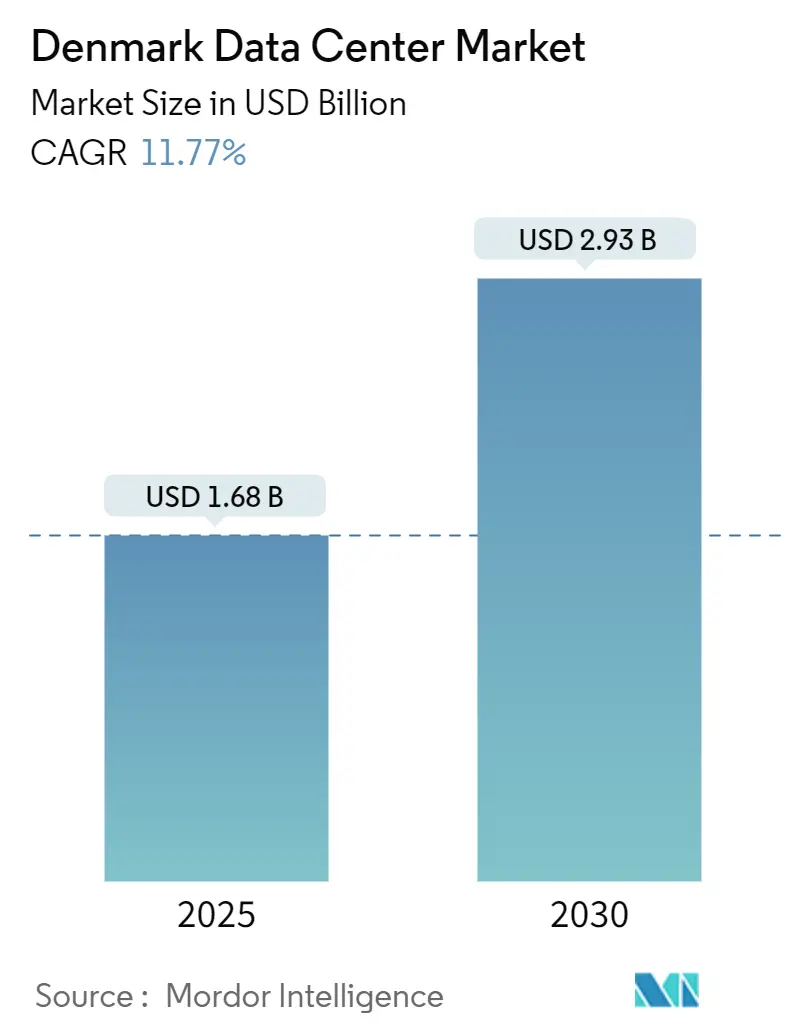
Denmark Data Center Market Analysis by Mordor Intelligence
Denmark Data Center Market size is estimated at USD 1.68 billion in 2025, and is expected to reach USD 2.93 billion by 2030, at a CAGR of 11.77% during the forecast period (2025-2030). In terms of the IT load capacity, the market is expected to grow from 556.10 megawatts in 2025 to 896.90 megawatts by 2030, at a CAGR of 10.03% during the forecast period (2025-2030). The market segment shares and estimates are calculated and reported in terms of MW. Rapid renewable-power deployment, 5G ubiquity, subsea cable landings, and fast-track permitting together create a virtuous cycle that draws global hyperscale and AI workloads to Denmark. Hyperscale operators capitalize on 95% very-high-capacity network coverage and 98% 5G coverage to position the country as a Nordic gateway for latency-sensitive cloud traffic. Robust corporate power-purchase-agreement activity and heat-reuse mandates underpin long-term sustainability commitments, while public–private investments such as the Gefion AI supercomputer showcase Denmark’s ability to host high-density infrastructure. Grid constraints and strict excess-heat price caps temper the outlook, yet policy tools continue to counterbalance these headwinds.
Key Report Takeaways
- By data center size, massive facilities led with a 39.53% capacity share in 2024 in the Denmark data center market and are expanding at a 12.40% CAGR through 2030, underscoring hyperscale consolidation.
- By tier standard, Tier 3 installations captured 50.21% of the 2024 base in n the Denmark data center market, whereas Tier 4 deployments record the fastest 10.90% CAGR as AI workloads demand higher fault tolerance.
- By data center type, hyperscale and self-built sites held 60.54% share in 2024 in n the Denmark data center market while posting an 11.90% CAGR, reflecting the dominance of cloud and AI providers.
- By end user industry, IT and telecom accounted for 60.74% of 2024 capacity in n the Denmark data center market, but BFSI is advancing at an 11.18% CAGR on the back of fintech digitalization and regulatory compliance.
- By hotspot, Copenhagen retained 51.43% capacity in 2024 in n the Denmark data center market, yet the rest of Denmark is progressing at a 12.50% CAGR because of lower land costs and proximity to renewable generation.
Denmark Data Center Market Trends and Insights
Driver Impact Analysis
| Driver | (~) % Impact on CAGR Forecast | Geographic Relevance | Impact Timeline |
|---|---|---|---|
| Cloud and AI-driven hyperscale expansion | +2.8% | National, concentrated in Copenhagen and Jutland | Medium term (2-4 years) |
| Renewable-power advantage and heat-reuse mandates | +2.1% | National, stronger in industrial regions | Long term (≥4 years) |
| 5G and nationwide FTTP enabling edge demand | +1.6% | National; early gains in Copenhagen, Aarhus, Odense | Short term (≤2 years) |
| Government tax incentives and fast-track permitting | +1.4% | National; priority zones in new industrial parks | Medium term (2-4 years) |
| Subsea cable landings boosting international connectivity | +1.2% | Coastal Jutland | Long term (≥4 years) |
| Corporate PPAs driving green-powered colocation | +0.9% | Near renewable generation hubs | Medium term (2-4 years) |
| Source: Mordor Intelligence | |||
Cloud and AI-driven hyperscale expansion
Gefion, the first Danish AI supercomputer running 1,528 NVIDIA H100 GPUs, exemplifies infrastructure requirements that are three-to-five times more power-dense than typical enterprise racks. Public–private funding models, such as Novo Nordisk Foundation’s DKK 600 million grant and state-backed EIFO financing, validate Denmark’s ability to attract specialized capital. Operators integrate direct-to-chip liquid cooling and 100% renewable contracts to meet EU sustainability rating schemes that became mandatory in September 2024. The resulting technical and environmental credentials solidify the Denmark data center market as a preferred AI deployment zone for global cloud providers.
Renewable-power advantage and heat-reuse mandates
The North Sea Energy Island aims to aggregate 10 GW of offshore wind and dedicate export transmission, giving hyperscale facilities an opportunity for direct renewable sourcing.[1]Danish Energy Agency, “Denmark’s Energy Islands,” ens.dk Operators such as TDC NET already exported 2,516 MWh surplus heat into district systems in 2023, proving circular-economy feasibility. The Green Investment Support Scheme allocates DKK 657 million in 2025, covering up to 15% of the costs associated with establishing renewable technology. Binding heat-reuse clauses in industrial-park zoning reinforce Denmark’s reputation for sustainable digital infrastructure, a differentiator against competing European hubs.
5G and nationwide FTTP enabling edge demand
By mid-2023, Denmark had achieved 100% 5G coverage and 84% fiber-to-the-premises reach, with coverage rising to above 90% in rural areas, thereby empowering autonomous systems and real-time analytics use cases.[2]U.S. International Trade Administration, “Denmark – Digital Economy,” trade.gov Quantum-secure pilot network QCI.DK, financed with EUR 6 million and rolled out on GlobalConnect fiber, signals Denmark’s ambition to pioneer post-quantum communications. Edge colocation gained momentum when Penta Infra acquired a second Copenhagen facility in September 2024, delivering low-latency compute capacity for IoT workloads. Such projects anchor distributed architecture growth within the Denmark data center market.
Government tax incentives and fast-track permitting
The “red-carpet” procedure caps administrative processing at 18 months for projects above DKK 100 million, while the Danish Business Authority’s one-stop shop smooths multilevel approvals. Foreign investments in critical infrastructure face clear timelines under the Investment Screening Act, creating predictability despite added oversight. Past relief packages for Apple and Meta illustrate the government’s willingness to tailor PSO cost exemptions that lower operating expenses, reinforcing the appeal of the Denmark data center market.
Restraints Impact Analysis
| Restraint | (~) % Impact on CAGR Forecast | Geographic Relevance | Impact Timeline |
|---|---|---|---|
| Looming Grid Capacity Deficit and Offshore Wind Delays | -1.8% | National, acute in Greater Copenhagen region | Short term (≤ 2 years) |
| Strict Excess-Heat Price-Cap Rules Limiting ROI | -1.2% | National, with stronger impact in urban areas | Medium term (2-4 years) |
| Scarcity of Data-Center Skilled Labour | -0.7% | National, concentrated in technical hub regions | Medium term (2-4 years) |
| Rising Land Prices in Greater Copenhagen | -0.5% | Greater Copenhagen metropolitan area | Short term (≤ 2 years) |
| Source: Mordor Intelligence | |||
Looming grid capacity deficit and offshore wind delays
Total data-center power draw, now 2 TWh, could quadruple by 2030, stressing substations and high-voltage corridors in Greater Copenhagen. While the 10 GW Energy Island provides a future remedy, construction timetables lag immediate capacity requirements. Klimarådet warns that an additional two offshore-wind parks are needed to keep pace with demand. Transmission upgrades compete with residential electrification projects, prolonging queue times for new grid connections and tempering near-term build-out for the Denmark data center market.
Strict excess-heat price-cap rules limiting ROI
Danish legislation caps heat sale prices to protect district heating consumers, effectively turning heat recovery systems into compliance cost centers rather than profit streams. Operators must still invest in heat-exchange hardware under environmental mandates, but limited revenue potential elongates payback periods. The upcoming NIS2 regime introduces additional cybersecurity spending and threat-reporting requirements, increasing fixed costs and further complicating return profiles for mid-sized providers.[3]Lexology Contributors, “NIS2 Is About to Become a Reality in Denmark,” lexology.com
Segment Analysis
By Data Center Size: Massive Facilities Drive Hyperscale Consolidation
Massive sites held 39.53% of Denmark data center market share in 2024 and will compound at 12.40% through 2030 as operators chase scale efficiencies. The Denmark data center market size for massive facilities is set to expand by 250 MW over the forecast horizon, anchored by atNorth’s 250 MW DEN02 campus in Ølgod. These projects use economies of scale to absorb compliance and sustainability costs more effectively than medium sites.
Consolidation pressures will intensify as hyperscale buyers lock in capacity years ahead, leaving smaller facilities to specialize in edge or regulated workloads. NIS2 costs dilute margins for sub-50 MW operators, accelerating mergers or closures. However, edge services and content-delivery nodes will still need local footprints, giving agile providers a niche within an otherwise scale-driven Denmark data center market.
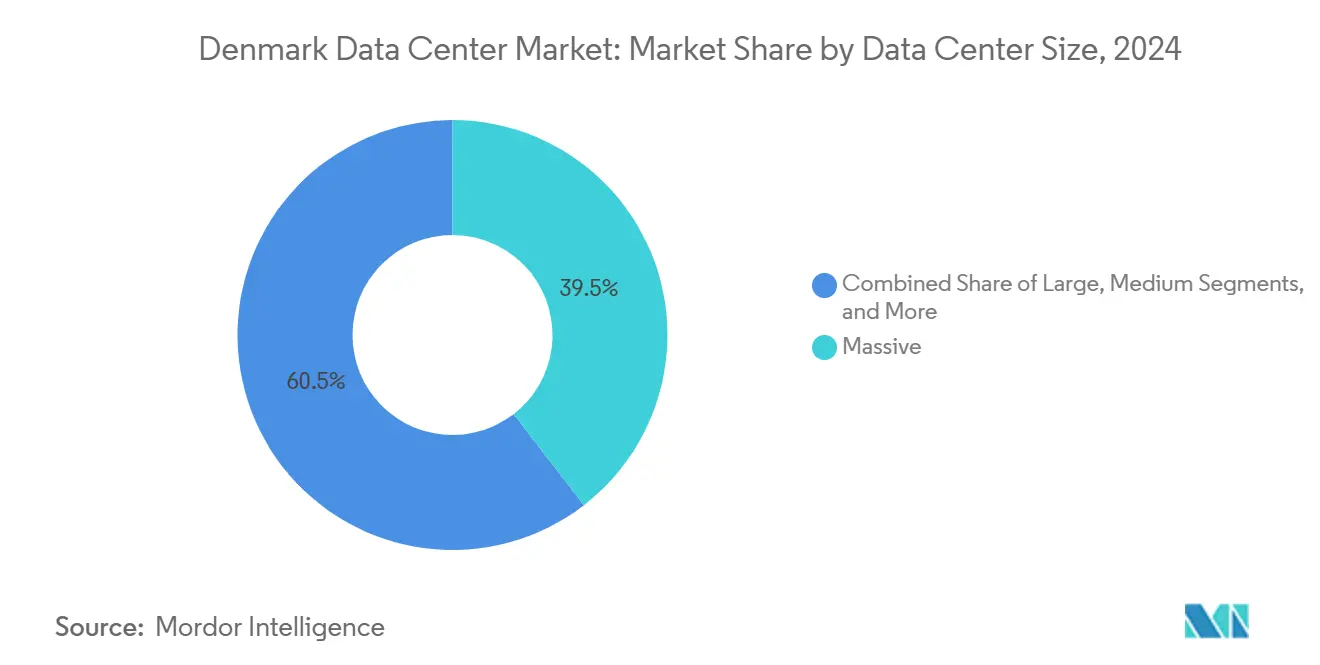
Note: Segment shares of all individual segments available upon report purchase
By Tier Standard: Tier 4 Acceleration Reflects AI Workload Requirements
Tier 3 accounted for 50.21% of 2024 capacity, yet Tier 4 posts a 10.90% CAGR through 2030 as AI and BFSI applications demand 99.995% uptime.[4]Danish Standards Foundation, “Danish Standards,” ds.dk Denmark data center market size allocated to Tier 4 will rise sharply after Gefion set a reliability precedent for research supercomputing.
Redundant feeds, dual-powered chillers, and fault-tolerant architectures attract premium pricing and justify long-term corporate PPAs. SMEs and dev-test use cases still fit Tier 2, but the strategic growth axis clearly favors higher tiers that can guarantee compliance with stringent digital-service-provider rules under NIS2.
By Data Center Type: Hyperscale Dominance Accelerates Through AI Adoption
Hyperscale and self-built facilities commanded 60.54% of the Denmark data center market in 2024 and are increasing at 11.90% CAGR as cloud majors deepen Nordic footprints. Denmark data center market size devoted to hyperscale is projected to add 340 MW by 2030, even after Meta’s pause in Odense signaled occasional strategy shifts.
Colocation is evolving toward wholesale suites as enterprise clients favor reserved capacity but prefer not to own real estate. GDPR and national-sovereignty clauses drive onshore hosting demand, enabling regional operators to secure regulated workloads even as the overall market growth centers on hyperscale.
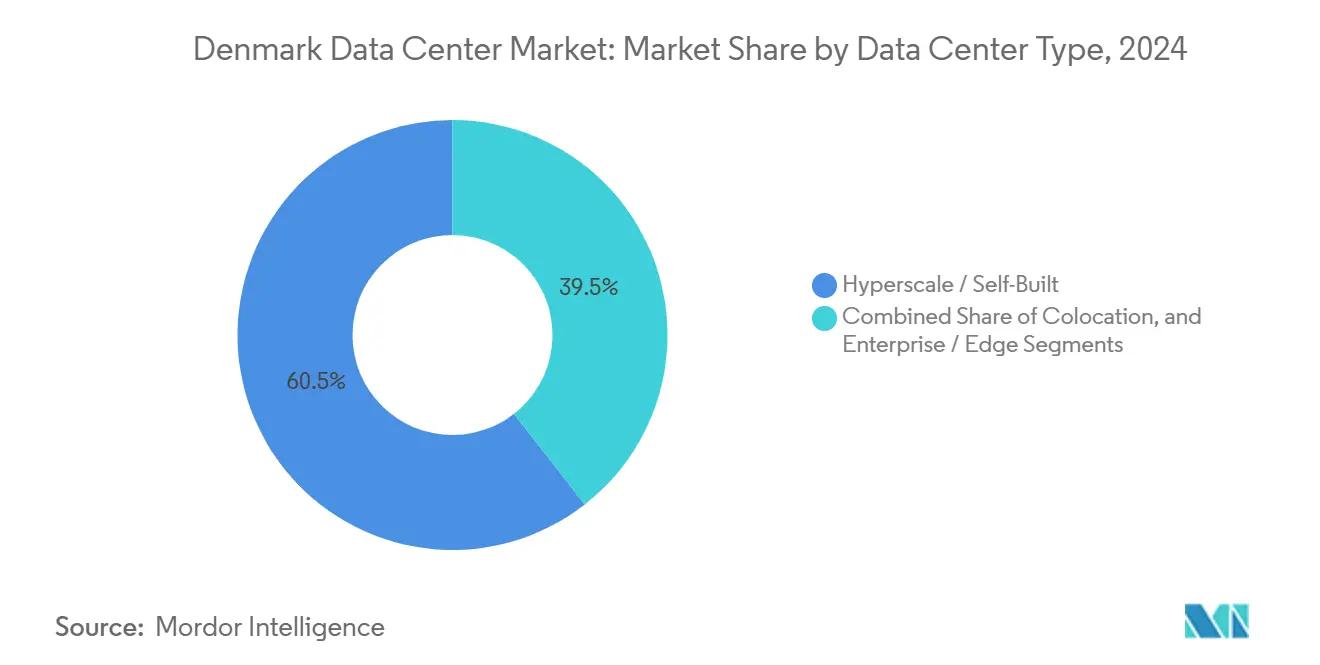
Note: Segment shares of all individual segments available upon report purchase
By End User Industry: BFSI Emerges as Fastest-Growing Segment
IT and telecom retained 60.74% share in 2024, yet BFSI climbs at 11.18% CAGR as fintech services, open-banking APIs, and RegTech analytics swell data volumes. Denmark data center market share for BFSI is expected to approach double-digits by 2030.
Life sciences and government also present rising demand because AI-enabled drug discovery and e-government platforms require sovereign, high-performance hosting. Content streaming leverages subsea routes for low-latency distribution, adding incrementally to overall utilization.
Geography Analysis
Copenhagen owns a slight majority of national capacity because subsea cables such as HAVFRUE deliver direct North American traffic, and the capital hosts most BFSI cores. Yet real-estate premiums and grid constraints limit additional hyperscale campuses in the metropolitan ring. Digital Realty’s Gefion deployment illustrates that high-density AI clusters can still flourish where dark-fibers converge, provided renewable PPAs offset carbon footprints.
Western Denmark, notably Jutland, captures outsized growth because vast onshore wind farms and abundant land lower total cost of ownership. atNorth’s 250 MW DEN02 is emblematic: proximity to both 400 kV lines and district heating networks allows the operator to monetize surplus heat while securing low-carbon power. Energy-island transmission corridors will reinforce this shift by granting near-direct access to 10 GW offshore capacity, making Jutland a preferred site for the next wave of Denmark data center market investments.
Rest-of-country diversification is further aided by TDC NET’s fiber backbone, which levels latency across regions and allows edge clusters in Odense, Aalborg, and Esbjerg to serve localized 5G traffic. Fast-track industrial-park zoning encourages municipalities to earmark grid-served parcels for digital infrastructure, ensuring that the Denmark data center market evolves into a balanced national grid rather than a single-city cluster.
Competitive Landscape
Competition is moderate, with global hyperscalers and regional specialists sharing the field. Apple, Google, Microsoft, and Meta anchor self-built campuses and long-term renewable PPAs, leveraging deep capital reserves to absorb compliance and sustainability spend. atNorth, Digital Realty, and GlobalConnect differentiate through local regulatory knowledge and heat-reuse engineering, enabling them to win wholesale and high-performance compute contracts. TDC NET leverages telecom assets and district heat exports, providing a sustainability narrative that resonates with corporate ESG targets.
M&A activity is expected to rise as NIS2 and grid upgrade costs prompt sub-20 MW operators to consider scale partnerships. Technology roadmaps pivot to liquid cooling and 100% fossil-free power procurement, areas where first movers already hold an edge. Quantum-secure interconnect pilots mark an emerging niche, and operators that can integrate post-quantum encryption alongside AI accelerators will capture premium BFSI and life sciences demand.
Barriers to entry include the Danish Investment Screening Act’s mandatory clearance for critical infrastructure investments exceeding DKK 100 million, as well as district-heat obligations that require upfront CAPEX with constrained revenue ceilings. These factors cement incumbents’ positions while filtering speculative entrants, gradually lifting the average facility scale across the Denmark data center market.
Denmark Data Center Industry Leaders
-
Apple Inc.
-
Microsoft Corporation
-
Google LLC
-
Cibicom A/S
-
NNIT A/S
- *Disclaimer: Major Players sorted in no particular order
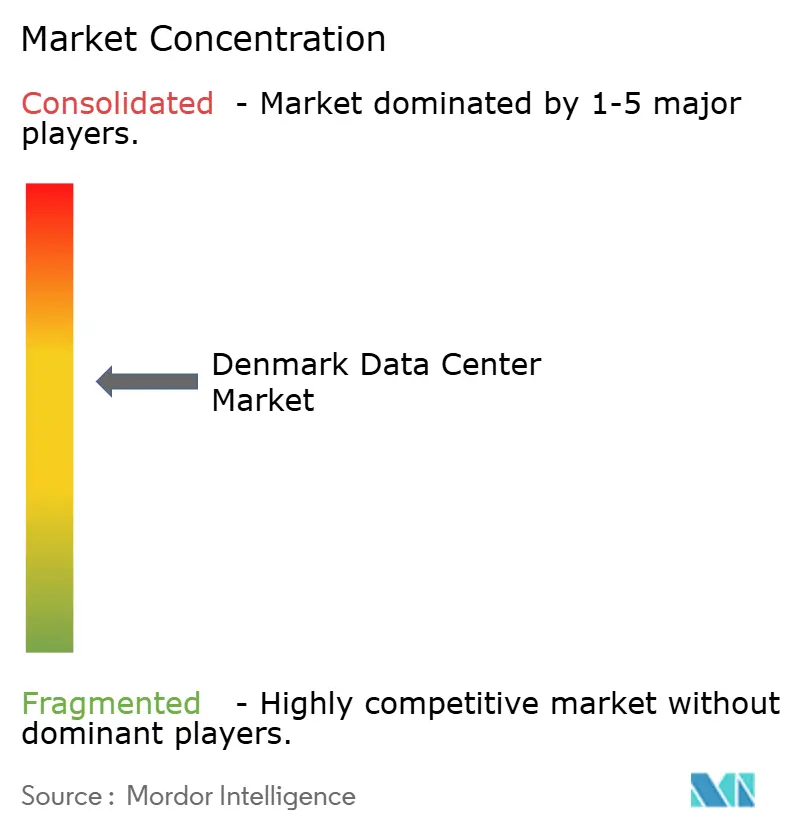
Recent Industry Developments
- October 2024: Novo Nordisk Foundation activated Gefion, Denmark’s first AI supercomputer, at Digital Realty Copenhagen after a DKK 600 million investment.
- October 2024: atNorth announced the 250 MW DEN02 campus in Ølgod, Denmark’s largest single data center investment.
- September 2024: Penta Infra bought a second Copenhagen edge facility to serve metro latency-sensitive workloads.
- June 2024: Meta paused its USD 342 million Odense expansion amid European portfolio realignment.
Denmark Data Center Market Report Scope
Copenhagen are covered as segments by Hotspot. Large, Massive, Medium, Mega, Small are covered as segments by Data Center Size. Tier 1 and 2, Tier 3, Tier 4 are covered as segments by Tier Type. Non-Utilized, Utilized are covered as segments by Absorption.| Large |
| Massive |
| Medium |
| Mega |
| Small |
| Tier 1 and 2 |
| Tier 3 |
| Tier 4 |
| Hyperscale / Self-Built | ||
| Enterprise / Edge | ||
| Colocation | Non-Utilized | |
| Utilized | Retail Colocation | |
| Wholesale Colocation | ||
| BFSI |
| IT and ITES |
| E-Commerce |
| Government |
| Manufacturing |
| Media and Entertainment |
| Telecom |
| Other End Users |
| Copenhagen |
| Rest of Denmark |
| By Data Center Size | Large | ||
| Massive | |||
| Medium | |||
| Mega | |||
| Small | |||
| By Tier Standard | Tier 1 and 2 | ||
| Tier 3 | |||
| Tier 4 | |||
| By Data Center Type | Hyperscale / Self-Built | ||
| Enterprise / Edge | |||
| Colocation | Non-Utilized | ||
| Utilized | Retail Colocation | ||
| Wholesale Colocation | |||
| By End User Industry | BFSI | ||
| IT and ITES | |||
| E-Commerce | |||
| Government | |||
| Manufacturing | |||
| Media and Entertainment | |||
| Telecom | |||
| Other End Users | |||
| By Hotspot | Copenhagen | ||
| Rest of Denmark | |||
Market Definition
- IT LOAD CAPACITY - The IT load capacity or installed capacity, refers to the amount of energy consumed by servers and network equipments placed in a rack installed. It is measured in megawatt (MW).
- ABSORPTION RATE - It denotes the extend to which the data center capacity has been leased out. For instance, a 100 MW DC has leased out 75 MW, then absorption rate would be 75%. It is also referred as utilization rate and leased-out capacity.
- RAISED FLOOR SPACE - It is an elevated space build over the floor. This gap between the original floor and the elevated floor is used to accommodate wiring, cooling, and other data center equipment. This arrangement assist in having proper wiring and cooling infrastructure. It is measured in square feet (ft^2).
- DATA CENTER SIZE - Data Center Size is segmented based on the raised floor space allocated to the data center facilities. Mega DC - # of Racks must be more than 9000 or RFS (raised floor space) must be more than 225001 Sq. ft; Massive DC - # of Racks must be in between 9000 and 3001 or RFS must be in between 225000 Sq. ft and 75001 Sq. ft; Large DC - # of Racks must be in between 3000 and 801 or RFS must be in between 75000 Sq. ft and 20001 Sq. ft; Medium DC # of Racks must be in between 800 and 201 or RFS must be in between 20000 Sq. ft and 5001 Sq. ft; Small DC - # of Racks must be less than 200 or RFS must be less than 5000 Sq. ft.
- TIER TYPE - According to Uptime Institute the data centers are classified into four tiers based on the proficiencies of redundant equipment of the data center infrastructure. In this segment the data center are segmented as Tier 1,Tier 2, Tier 3 and Tier 4.
- COLOCATION TYPE - The segment is segregated into 3 categories namely Retail, Wholesale and Hyperscale Colocation service. The categorization is done based on the amount of IT load leased out to potential customers. Retail colocation service has leased capacity less than 250 kW; Wholesale colocation services has leased capacity between 251 kW and 4 MW and Hyperscale colocation services has leased capacity more than 4 MW.
- END CONSUMERS - The Data Center Market operates on a B2B basis. BFSI, Government, Cloud Operators, Media and Entertainment, E-Commerce, Telecom and Manufacturing are the major end-consumers in the market studied. The scope only includes colocation service operators catering to the increasing digitalization of the end-user industries.
| Keyword | Definition |
|---|---|
| Rack Unit | Generally referred as U or RU, it is the unit of measurement for the server unit housed in the racks in the data center. 1U is equal to 1.75 inches. |
| Rack Density | It defines the amount of power consumed by the equipment and server housed in a rack. It is measured in kilowatt (kW). This factor plays a critical role in data center design and, cooling and power planning. |
| IT Load Capacity | The IT load capacity or installed capacity, refers to the amount of energy consumed by servers and network equipment placed in a rack installed. It is measured in megawatt (MW). |
| Absorption Rate | It denotes how much of the data center capacity has been leased out. For instance, if a 100 MW DC has leased out 75 MW, then the absorption rate would be 75%. It is also referred to as utilization rate and leased-out capacity. |
| Raised Floor Space | It is an elevated space built over the floor. This gap between the original floor and the elevated floor is used to accommodate wiring, cooling, and other data center equipment. This arrangement assists in having proper wiring and cooling infrastructure. It is measured in square feet/meter. |
| Computer Room Air Conditioner (CRAC) | It is a device used to monitor and maintain the temperature, air circulation, and humidity inside the server room in the data center. |
| Aisle | It is the open space between the rows of racks. This open space is critical for maintaining the optimal temperature (20-25 °C) in the server room. There are primarily two aisles inside the server room, a hot aisle and a cold aisle. |
| Cold Aisle | It is the aisle wherein the front of the rack faces the aisle. Here, chilled air is directed into the aisle so that it can enter the front of the racks and maintain the temperature. |
| Hot Aisle | It is the aisle where the back of the racks faces the aisle. Here, the heat dissipated from the equipment’s in the rack is directed to the outlet vent of the CRAC. |
| Critical Load | It includes the servers and other computer equipment whose uptime is critical for data center operation. |
| Power Usage Effectiveness (PUE) | It is a metric which defines the efficiency of a data center. It is calculated by: (𝑇𝑜𝑡𝑎𝑙 𝐷𝑎𝑡𝑎 𝐶𝑒𝑛𝑡𝑒𝑟 𝐸𝑛𝑒𝑟𝑔𝑦 𝐶𝑜𝑛𝑠𝑢𝑚𝑝𝑡𝑖𝑜𝑛)/(𝑇𝑜𝑡𝑎𝑙 𝐼𝑇 𝐸𝑞𝑢𝑖𝑝𝑚𝑒𝑛𝑡 𝐸𝑛𝑒𝑟𝑔𝑦 𝐶𝑜𝑛𝑠𝑢𝑚𝑝𝑡𝑖𝑜𝑛). Further, a data center with a PUE of 1.2-1.5 is considered highly efficient, whereas, a data center with a PUE >2 is considered highly inefficient. |
| Redundancy | It is defined as a system design wherein additional component (UPS, generators, CRAC) is added so that in case of power outage, equipment failure, the IT equipment should not be affected. |
| Uninterruptible Power Supply (UPS) | It is a device that is connected in series with the utility power supply, storing energy in batteries such that the supply from UPS is continuous to IT equipment even during utility power is snapped. The UPS primarily supports the IT equipment only. |
| Generators | Just like UPS, generators are placed in the data center to ensure an uninterrupted power supply, avoiding downtime. Data center facilities have diesel generators and commonly, 48-hour diesel is stored in the facility to prevent disruption. |
| N | It denotes the tools and equipment required for a data center to function at full load. Only "N" indicates that there is no backup to the equipment in the event of any failure. |
| N+1 | Referred to as 'Need plus one', it denotes the additional equipment setup available to avoid downtime in case of failure. A data center is considered N+1 when there is one additional unit for every 4 components. For instance, if a data center has 4 UPS systems, then for to achieve N+1, an additional UPS system would be required. |
| 2N | It refers to fully redundant design wherein two independent power distribution system is deployed. Therefore, in the event of a complete failure of one distribution system, the other system will still supply power to the data center. |
| In-Row Cooling | It is the cooling design system installed between racks in a row where it draws warm air from the hot aisle and supplies cool air to the cold aisle, thereby maintaining the temperature. |
| Tier 1 | Tier classification determines the preparedness of a data center facility to sustain data center operation. A data center is classified as Tier 1 data center when it has a non-redundant (N) power component (UPS, generators), cooling components, and power distribution system (from utility power grids). The Tier 1 data center has an uptime of 99.67% and an annual downtime of <28.8 hours. |
| Tier 2 | A data center is classified as Tier 2 data center when it has a redundant power and cooling components (N+1) and a single non-redundant distribution system. Redundant components include extra generators, UPS, chillers, heat rejection equipment, and fuel tanks. The Tier 2 data center has an uptime of 99.74% and an annual downtime of <22 hours. |
| Tier 3 | A data center having redundant power and cooling components and multiple power distribution systems is referred to as a Tier 3 data center. The facility is resistant to planned (facility maintenance) and unplanned (power outage, cooling failure) disruption. The Tier 3 data center has an uptime of 99.98% and an annual downtime of <1.6 hours. |
| Tier 4 | It is the most tolerant type of data center. A Tier 4 data center has multiple, independent redundant power and cooling components and multiple power distribution paths. All IT equipment are dual powered, making them fault tolerant in case of any disruption, thereby ensuring interrupted operation. The Tier 4 data center has an uptime of 99.74% and an annual downtime of <26.3 minutes. |
| Small Data Center | Data center that has floor space area of ≤ 5,000 Sq. ft or the number of racks that can be installed is ≤ 200 is classified as a small data center. |
| Medium Data Center | Data center which has floor space area between 5,001-20,000 Sq. ft, or the number of racks that can be installed is between 201-800, is classified as a medium data center. |
| Large Data Center | Data center which has floor space area between 20,001-75,000 Sq. ft, or the number of racks that can be installed is between 801-3,000, is classified as a large data center. |
| Massive Data Center | Data center which has floor space area between 75,001-225,000 Sq. ft, or the number of racks that can be installed is between 3001-9,000, is classified as a massive data center. |
| Mega Data Center | Data center that has a floor space area of ≥ 225,001 Sq. ft or the number of racks that can be installed is ≥ 9001 is classified as a mega data center. |
| Retail Colocation | It refers to those customers who have a capacity requirement of 250 kW or less. These services are majorly opted by small and medium enterprises (SMEs). |
| Wholesale Colocation | It refers to those customers who have a capacity requirement between 250 kW to 4 MW. These services are majorly opted by medium to large enterprises. |
| Hyperscale Colocation | It refers to those customers who have a capacity requirement greater than 4 MW. The hyperscale demand primarily originates from large-scale cloud players, IT companies, BFSI, and OTT players (like Netflix, Hulu, and HBO+). |
| Mobile Data Speed | It is the mobile internet speed a user experiences via their smartphones. This speed is primarily dependent on the carrier technology being used in the smartphone. The carrier technologies available in the market are 2G, 3G, 4G, and 5G, where 2G provides the slowest speed while 5G is the fastest. |
| Fiber Connectivity Network | It is a network of optical fiber cables deployed across the country, connecting rural and urban regions with high-speed internet connection. It is measured in kilometer (km). |
| Data Traffic per Smartphone | It is a measure of average data consumption by a smartphone user in a month. It is measured in gigabyte (GB). |
| Broadband Data Speed | It is the internet speed that is supplied over the fixed cable connection. Commonly, copper cable and optic fiber cable are used in both residential and commercial use. Here, optic cable fiber provides faster internet speed than copper cable. |
| Submarine Cable | A submarine cable is a fiber optic cable laid down at two or more landing points. Through this cable, communication and internet connectivity between countries across the globe is established. These cables can transmit 100-200 terabits per second (Tbps) from one point to another. |
| Carbon Footprint | It is the measure of carbon dioxide generated during the regular operation of a data center. Since, coal, and oil & gas are the primary source of power generation, consumption of this power contributes to carbon emissions. Data center operators are incorporating renewable energy sources to curb the carbon footprint emerging in their facilities. |
Research Methodology
Mordor Intelligence follows a four-step methodology in all our reports.
- Step-1: Identify Key Variables: In order to build a robust forecasting methodology, the variables and factors identified in Step-1 are tested against available historical market numbers. Through an iterative process, the variables required for market forecast are set and the model is built on the basis of these variables.
- Step-2: Build a Market Model: Market-size estimations for the forecast years are in nominal terms. Inflation is not a part of the pricing, and the average selling price (ASP) is kept constant throughout the forecast period for each country.
- Step-3: Validate and Finalize: In this important step, all market numbers, variables and analyst calls are validated through an extensive network of primary research experts from the market studied. The respondents are selected across levels and functions to generate a holistic picture of the market studied.
- Step-4: Research Outputs: Syndicated Reports, Custom Consulting Assignments, Databases & Subscription Platforms
